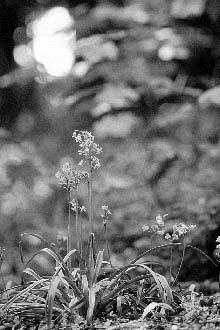
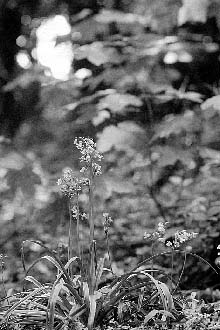

Photography, in its original and purest form, is about both artistic and technical creativity. It is about the desire to create not just pictures but also the means with which they are recorded. In recognition of this fact, I am devoting this month's column to a few technical aspects that can easily become the subject of experimentation, and can yield useful results in the process.
In days of old, lenses didn�t have variable aperture diaphragms, but rather were regulated using Waterhouse Stops. These were thin sheets of metal, each machined with a different size hole, that were slid into the lens through a narrow slit in its casing. While this was an effective means of controlling exposure and changing depth of field, it was poorly suited to the development of more sophisticated (AE) camera systems. So it was that the iris diaphragm was born.
Even though this is not the perfect solution, its advantages generally outweighed its problems, and attention largely moved away from the short-comings in favour of the benefits. Any return to the earlier system could only be justified by the moving of now well-established goal-posts, focusing on the advantages of the original technique - and also exposing modern systems' disadvantages at the same time.


Left - taken on a 135mm f2.8 Nikkor lens at full, circular aperture; right, taken stopped down to f5.6, showing how the out of focus image reflects the polygonal iris diaphragm shape
The biggest disadvantage of variable apertures is the fact that they change in shape as they change in size. At maximum size, the aperture takes the shape of the lens, a circle. As sizes decrease, the iris closes down to give aperture shapes that depend on the number of blades used in its construction. For some strange reason, most variable apertures have an odd number of blades, typically five, seven or nine, with newer lenses tending to have fewer blades. While the form of the aperture stays constant during stop-down, the steepness of the angles between the blades increases. This is a very important point, for it is at these angles, not across the full aperture, that image-degrading diffraction occurs.
For this reason, small bright lights included in a picture against dark backgrounds show a star-burst effect (where the number of 'rays' is the same as the number of angles in the iris) and not a series of concentric rings as would be the case if it was the diameter of the aperture that was causing diffraction. Even if this extreme is not reached, out-of-focus highlights take on the shape of the iris (see the images above), yielding angular backgrounds that can be inappropriate for certain subjects.
A truly circular iris would not show these effects at all, though it could still show the circular diffraction effect if it was sufficiently small in size. It would therefore seem true to say that circular apertures are capable of producing higher quality images than are angled apertures.
Although greater numbers of blades give apertures that get closer to exact circles, and so ought to improve image quality, there appears to be no obvious correlation between lens price and the number of blades used in the diaphragm. Indeed, it would seem likely that iris design is an area that has been either neglected in favour of efforts elsewhere or compromised to keep costs down (Jon - compare a pre-war Leitz Elmar, with its near-circular diaphragm, with the widely disliked f2 Summar and its un-Leitz-like five-blader - Ed.).
The reason why pictures shot using a catadioptric (mirror) lens show donut shaped background highlights is because the front element has an opaque area where the reflex mirror is. This, combined with the fact that out-of-focus images have a structure that depends on both the object photographed and the lens aperture shape, creates the observed effect.
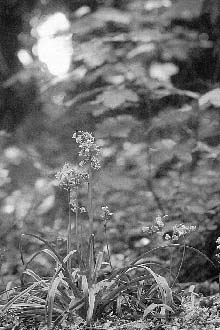
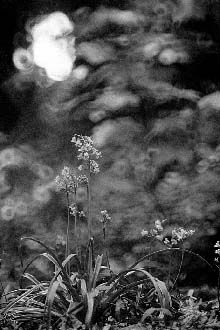
Left, the smooth unfocused image created by putting a 1 inch circular aperture in front of the Nikon 135mm wide open, instead of using the lens's f5.6 setting. Right, the donut effect achieved by placing a similar sized disc in the centre of the lens front (lightly stick a disc to the center of a clear filter)
By extension, placing shaped masks over the front element of a conventional lens will also change the appearance of out-of-focus highlights. For example, a small black disk over the centre of a fast conventional lens will give the same dohnut appearance as is characteristic of catadioptric lenses (see photo 4). Similarly, a wedding photographer friend of mine uses a diagonal slit that gives backgrounds a streaky look, as if they were exposed through smeared vaseline, while the sharp foreground remains unaffected (see photo 5, below).
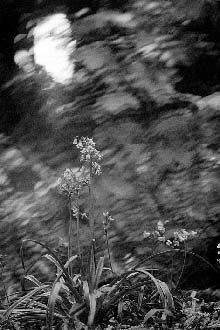
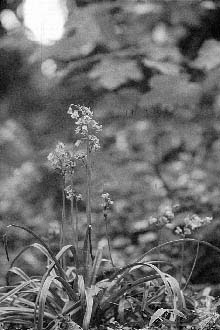
Left, the effect of a linear slit aperture in front of the lens. Right, an experiment using an old brass-mounted 6 inch lens with an f11 Waterhouse stop, on the same camera via bellows
To explore other possibilities, just play around with black paper and a scalpel. For best results, the masks should be large and bold, and the lens should be used at maximum aperture. To ease handling, masks can be stuck to plain Cokin sheets (Basic Filters, code 376) then supported in front of the lens using the usual holder. Cokin also make a plastic slit aperture for their 'A' system.
The second way of exploring lens effects is using old-fashioned (usually brass) lenses adapted to modern cameras. In principle, the fitting is a simple matter because there are no links (mechanical or electronic) to be made between the body and the lens. In practice, care must be taken to avoid fouling whatever linkages may exist on the camera itself. Further complications arise from the fact that old lenses often don�t have focusing mechanisms, having been focused on bellows when fitted to their original cameras.
The simplest answer is to keep this mode of working, mounting old lenses onto bellows normally used for close-up work. Provided that very short focal length lenses are avoided, this method works well. It is surprising how crudely, yet successfully, a lens can be gaffer-taped onto bellows for preliminary trials! When a more permanent arrangement is needed, custom adaptors can be fabricated by either a local machine shop or, for example, British adaptor specialists SRB (+44 1582 572471).
Since old lenses don't normally have in-built shutters, they are most conveniently used on cameras with focal plane shutters. This tends to mean 35mm cameras, though medium format cameras such as Mamiya's excellent 645 Pro and Hasselblad's F types can also be used. For cameras that don't have internal shutters, a shutter box can be fitted between the lens and the body.
Shutter boxes, like old brass lenses, can be obtained from junk shops, boot sales, second-hand camera dealers and specialist outlets. Of the latter, one of the best and most helpful in Britain is Classic Collection in Pied Bull Yard, London WC1 (+44 171 831 6000). Lenses are typically priced from about �20 pounds UK upwards (slightly more when supplied complete with a set of Waterhouse stops), though shutter boxes, being rather less common (especially in full working order) are normally a little more costly - which, together with the availability of TTL metering at the working aperture, is another good reason to use focal plane shuttered cameras.
The experimental potential of old lenses is huge and this is therefore a subject to which I will return again in a future issue. For now, suffice to give photo 6, a picture shot using a 6" brass lens fitted with an f11 Waterhouse Stop.
All illustrations on Polapan Instant 35mm reversal film.